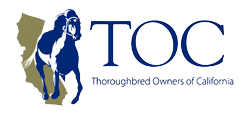Developing an “Eye” for a Horse
By John W. Russell
There are many mysteries about horse racing that are hard to explain, but judging and evaluating horses’ conformation need not be
as subjective an exercise as many horsemen would like to suggest. However, it is also true that there is no formula to define the
perfect horse, and what is written here would not come close to describing the complexity and function of the bone, muscle and sinew of the optimum Thoroughbred racehorse. Good horses come in different sizes, so it is important that any dimension from one given anatomical point to another must be in good relational balance to the entire horse. Thus the tape measure may best be used to measure a buyer’s bankroll, and not a horse. When a horse is running there are basically three components at work: the head and neck are providing balance, the hind quarters, loins, and hind legs produce forward thrust, and the shoulders and forelegs provide a pivot and bear the vast majority of weight. It is, therefore, a great benefit to the trained eye to see a horse in action when evaluating him, but fundamental truths can be appreciated in the standing horse that is squarely balanced on four legs.
Hind End Provides Propulsion
The hindquarters, when being seen from the side, should present a large triangle with the three corners being the point of the hip,
point of the butt and the stifle (see Diagram 1). The two most important sides of this triangle, hip to point of butt and hip to point of stifle should be approximately equal, and each to the same length as that of the horse’s back. The length of the gaskin, from the stifle to the hock should be slightly longer and never shorter than the length of the hind cannon bone. Ideally, the hindquarter should appear to be deep and the gaskin long. The angle of the hind leg is critical. Too straight a hock is just as bad as a crooked or sickle hock. To determine a correct angle, an imaginary line running upward through the length of the gaskin should point at the point of the hip, and a line running up through the cannon bone should point at the point of the butt (Diagram 1). Viewed from behind, the hindquarters should be symmetrical and well muscled over the hips and barely narrower than the horse’s rib cage. (Diagram 2). Also from the rear, the gaskin, well muscled, should slant slightly in from the stifle to the hock, but never should the hocks turn in, and they should be directly vertical above the fetlock. If all of these ingredients are in place, the horse should appear well balanced with no exaggerated dimensions. A short back is most desirable; the withers being about the same height as the hindquarters. The slope of the shoulder will determine the length of the stride when the horse is running, but will also dictate this when he is walking. The scapula, or shoulder blade, provides an obvious ridge that defines this slope, which should be about 40 degrees from a vertical line running up from the point of the shoulder.
Front End Bears Majority of Weight
The front legs bear the majority of weight of the running horse and rider, and therefore are far more susceptible to injury than the hind legs. Consequently, horsemen will spend a prodigious amount of time evaluating the front legs before a purchase. The forearm should be longer than the cannon bone, and should present a visually straight line with it from any point of observation (Diagram 3a). An almost unforgivable fault is when, viewed from the side, the knee is back (Diagram 3c), giving an almost concave appearance to the front of the leg. A knee that is slightly forward is of less concern, but in extreme cases, will put undue strain on the suspensory ligaments in the fetlock (Diagram 3b). When viewed from the front, anything less than perfect alignment of all the bones of the front legs are less than desirable (see Diagram 4). It is true, however, that there have been many very good horses (e.g. Real Quiet) with less than perfect legs, but any deviation from correct increases the possibility of injury, if not inhibiting the horse’s ability. Of no less importance, the pasterns and the hooves should line up well, and viewed from the side, should present approximately the same angle to the ground as the shoulder. The length of the pastern should be no longer than twice the length of the hoof. A heavy, barrel chest is undesirable, and should not be as wide as the hips. On the other hand, the girth should be as deep as possible as this is where the lungs are, and their capacity to absorb oxygen when stressed is largely related to their size. The neck should be set on perpendicular to the slope of the horse’s shoulder and should be longer than the back. Finally, although somewhat more subjective, an attractive head should be wide between large eyes with the jaw bones, at the throat, at least four inches apart. But bear in mind what one legendary horseman once said: “No one knows what’s inside a horse until he shows you,” and that particularly applies to the head of any horse.
While a racehorse with “correct” conformation may not necessarily be the fastest, such an individual usually proves to be more durable than a poorly-conformed horse. It’s important, therefore, to have a good understanding of conformation when selecting horses.
John W. Russell retired after training more than 50 stakes-winners of over 100 stakes, including Eclipse Award winners Susan’s Girl and Track Robbery.
